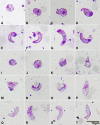Transmission blocking activity of a standardized neem (Azadirachta indica) seed extract on the rodent malaria parasite Plasmodium berghei in its vector Anopheles stephensi
- PMID: 20196858
- PMCID: PMC2846955
- DOI: 10.1186/1475-2875-9-66
Transmission blocking activity of a standardized neem (Azadirachta indica) seed extract on the rodent malaria parasite Plasmodium berghei in its vector Anopheles stephensi
Abstract
Background: The wide use of gametocytocidal artemisinin-based combination therapy (ACT) lead to a reduction of Plasmodium falciparum transmission in several African endemic settings. An increased impact on malaria burden may be achieved through the development of improved transmission-blocking formulations, including molecules complementing the gametocytocidal effects of artemisinin derivatives and/or acting on Plasmodium stages developing in the vector. Azadirachtin, a limonoid (tetranortriterpenoid) abundant in neem (Azadirachta indica, Meliaceae) seeds, is a promising candidate, inhibiting Plasmodium exflagellation in vitro at low concentrations. This work aimed at assessing the transmission-blocking potential of NeemAzal(R), an azadirachtin-enriched extract of neem seeds, using the rodent malaria in vivo model Plasmodium berghei/Anopheles stephensi.
Methods: Anopheles stephensi females were offered a blood-meal on P. berghei infected, gametocytaemic BALB/c mice, treated intraperitoneally with NeemAzal, one hour before feeding. The transmission-blocking activity of the product was evaluated by assessing oocyst prevalence, oocyst density and capacity to infect healthy mice. To characterize the anti-plasmodial effects of NeemAzal(R) on early midgut stages, i.e. zygotes and ookinetes, Giemsa-stained mosquito midgut smears were examined.
Results: NeemAzal completely blocked P. berghei development in the vector, at an azadirachtin dose of 50 mg/kg mouse body weight. The totally 138 examined, treated mosquitoes (three experimental replications) did not reveal any oocyst and none of the healthy mice exposed to their bites developed parasitaemia. The examination of midgut content smears revealed a reduced number of zygotes and post-zygotic forms and the absence of mature ookinetes in treated mosquitoes. Post-zygotic forms showed several morphological alterations, compatible with the hypothesis of an azadirachtin interference with the functionality of the microtubule organizing centres and with the assembly of cytoskeletal microtubules, which are both fundamental processes in Plasmodium gametogenesis and ookinete formation.
Conclusions: This work demonstrated in vivo transmission blocking activity of an azadirachtin-enriched neem seed extract at an azadirachtin dose compatible with 'druggability' requisites. These results and evidence of anti-plasmodial activity of neem products accumulated over the last years encourage to convey neem compounds into the drug discovery & development pipeline and to evaluate their potential for the design of novel or improved transmission-blocking remedies.
Figures



Similar articles
-
In vitro and ex vivo activity of an Azadirachta indica A.Juss. seed kernel extract on early sporogonic development of Plasmodium in comparison with azadirachtin A, its most abundant constituent.Phytomedicine. 2016 Dec 15;23(14):1743-1752. doi: 10.1016/j.phymed.2016.10.019. Epub 2016 Oct 28. Phytomedicine. 2016. PMID: 27912876
-
Impact of repeated NeemAzal-treated blood meals on the fitness of Anopheles stephensi mosquitoes.Parasit Vectors. 2015 Feb 10;8:94. doi: 10.1186/s13071-015-0700-1. Parasit Vectors. 2015. PMID: 25884799 Free PMC article.
-
Transmission blocking effects of neem (Azadirachta indica) seed kernel limonoids on Plasmodium berghei early sporogonic development.Fitoterapia. 2016 Oct;114:122-126. doi: 10.1016/j.fitote.2016.09.008. Epub 2016 Sep 15. Fitoterapia. 2016. PMID: 27642038
-
Neem-based products as potential eco-friendly mosquito control agents over conventional eco-toxic chemical pesticides-A review.Acta Trop. 2023 Apr;240:106858. doi: 10.1016/j.actatropica.2023.106858. Epub 2023 Feb 5. Acta Trop. 2023. PMID: 36750152 Review.
-
Implications of Time Bomb model of ookinete invasion of midgut cells.Insect Biochem Mol Biol. 2002 Oct;32(10):1311-6. doi: 10.1016/s0965-1748(02)00093-0. Insect Biochem Mol Biol. 2002. PMID: 12225921 Review.
Cited by
-
Anti-plasmodial effects of Azadirachta indica in experimental cerebral malaria: Apoptosis of cerebellar Purkinje cells of mice as a marker.N Am J Med Sci. 2010 Nov;2(11):518-25. doi: 10.4297/najms.2010.2518. N Am J Med Sci. 2010. PMID: 22558559 Free PMC article.
-
Contemporary exploitation of natural products for arthropod-borne pathogen transmission-blocking interventions.Parasit Vectors. 2022 Aug 24;15(1):298. doi: 10.1186/s13071-022-05367-8. Parasit Vectors. 2022. PMID: 36002857 Free PMC article. Review.
-
4-(1H)-Quinolones and 1,2,3,4-Tetrahydroacridin-9(10H)-ones prevent the transmission of Plasmodium falciparum to Anopheles freeborni.Antimicrob Agents Chemother. 2013 Dec;57(12):6187-95. doi: 10.1128/AAC.00492-13. Epub 2013 Sep 30. Antimicrob Agents Chemother. 2013. PMID: 24080648 Free PMC article.
-
Azadirachta indica ethanolic extract protects neurons from apoptosis and mitigates brain swelling in experimental cerebral malaria.Malar J. 2013 Aug 29;12:298. doi: 10.1186/1475-2875-12-298. Malar J. 2013. PMID: 23984986 Free PMC article.
-
Antiplasmodial natural products: an update.Malar J. 2019 Dec 5;18(1):404. doi: 10.1186/s12936-019-3026-1. Malar J. 2019. PMID: 31805944 Free PMC article. Review.
References
-
- World Health Organization. Global malaria control and elimination: report of a technical review. Geneva: World Health Organization; 2008.
-
- Sutherland CJ, Alloueche A, Curtis J, Drakeley CJ, Ord R, Duraisingh M, Greenwood BM, Pinder M, Warhurst D, Targett GA. Gambian children successfully treated with chloroquine can harbor and transmit Plasmodium falciparum gametocytes carrying resistance genes. Am J Trop Med Hyg. 2002;67:578–585. - PubMed
-
- Hallett RL, Sutherland CJ, Alexander N, Ord R, Jawara M, Drakeley CJ, Pinder M, Walraven G, Targett GA, Alloueche A. Combination therapy counteracts the enhanced transmission of drug-resistant malaria parasites to mosquitoes. Antimicrob Agents Chemother. 2004;48:3940–3943. doi: 10.1128/AAC.48.10.3940-3943.2004. - DOI - PMC - PubMed
Publication types
MeSH terms
Substances
LinkOut - more resources
Full Text Sources

